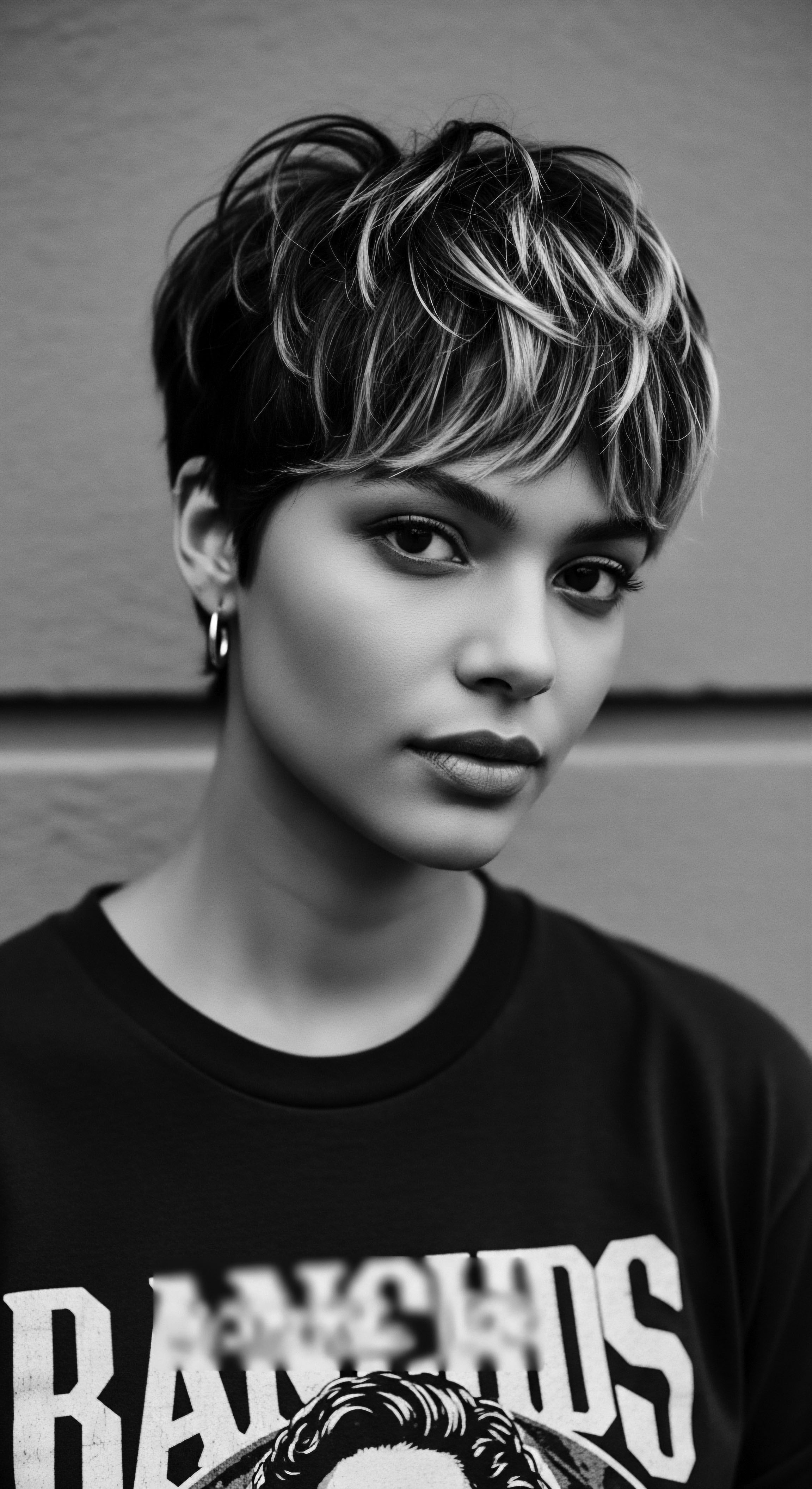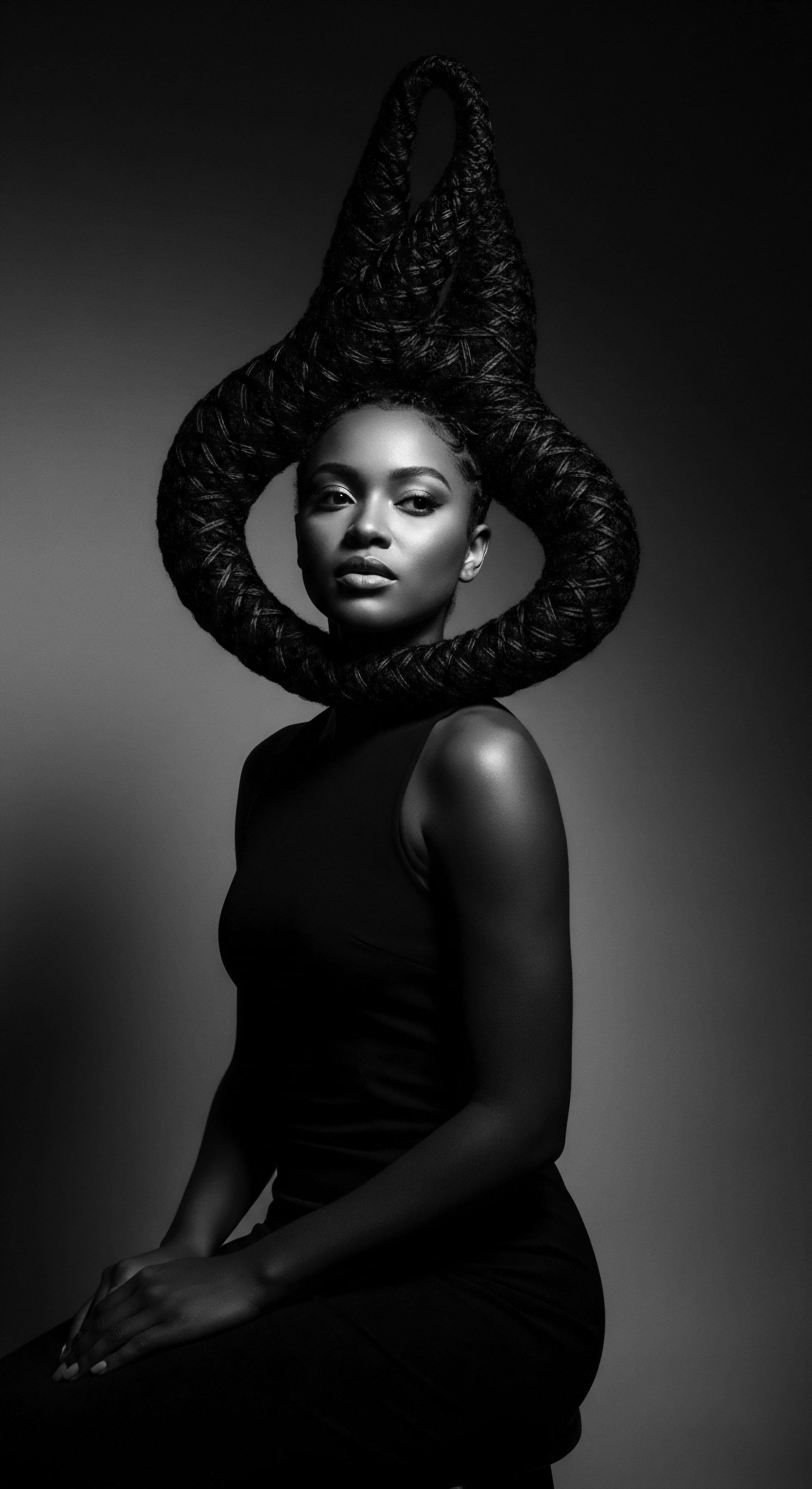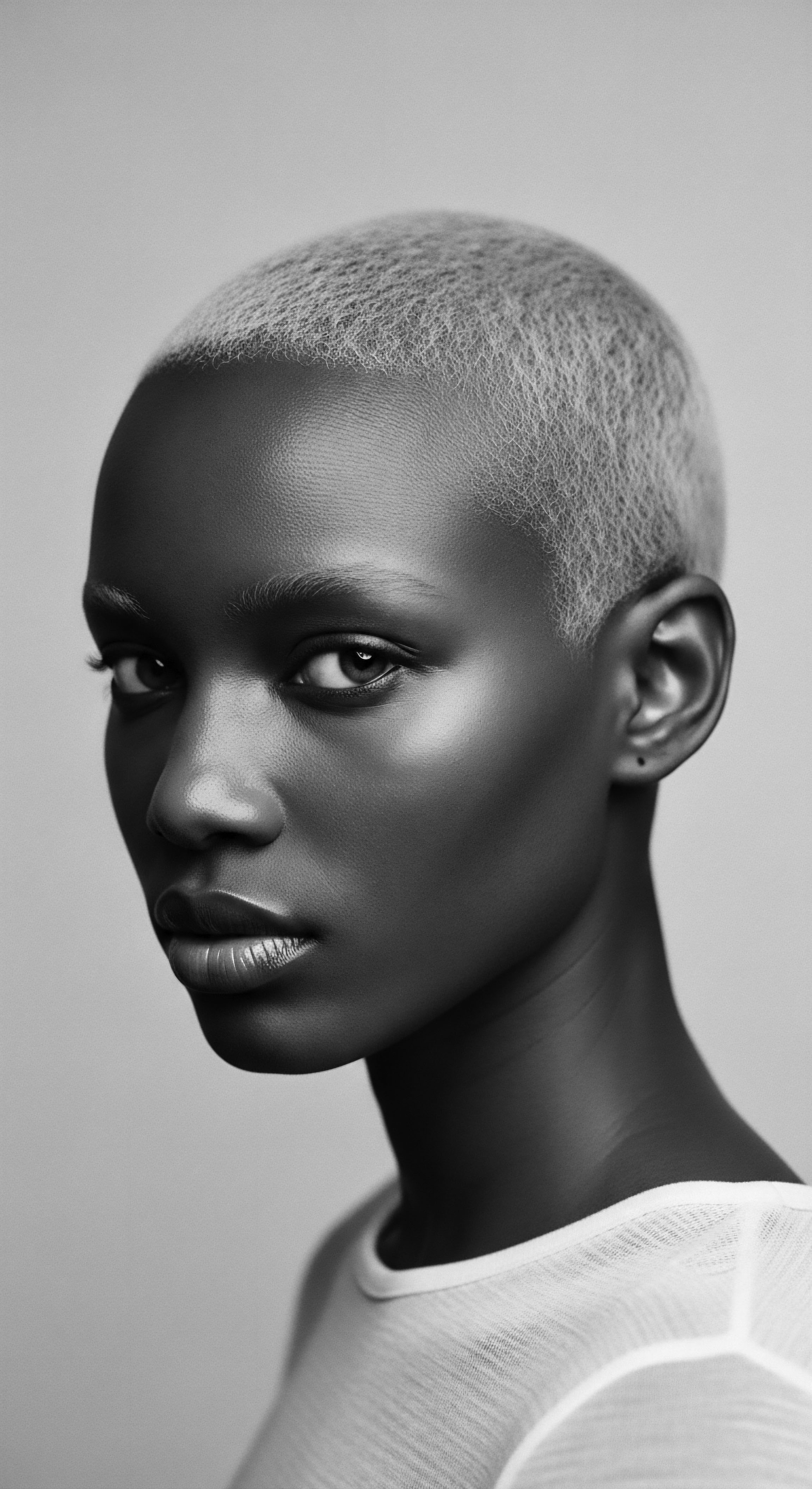
Roots
To truly understand the biological needs of textured hair, we must begin at the source, deep within the soil of history and ancestral wisdom. Our hair, a living extension of self, carries not only genetic code but also echoes of sun-drenched landscapes, communal gatherings, and the ceaseless ingenuity of those who came before us. This is not merely about scientific diagrams or molecular structures; it speaks to a profound lineage, a story etched into every curl, coil, and wave.

The Architecture of Ancestry
Textured hair stands apart, a marvel of biological adaptation. Its structure, far from simple, holds secrets passed down through generations. Consider the hair follicle itself, not a straight cylinder, but an elongated, curved pathway. This unique shape dictates the very spiral of the hair strand as it emerges from the scalp.
The flatter the oval of this follicle, the tighter the resulting curl or coil. This morphological distinction means textured hair often presents with an uneven diameter along its length, creating natural points where strength can be challenged.
Early human ancestors living in the intense heat of Africa developed afro-textured hair as an adaptive mechanism. This structure offered protection from the sun’s harsh ultraviolet radiation. Scholars also suggest its spiraled form and wider follicular pattern permitted air circulation around the scalp, assisting in cooling.
This biological inheritance highlights that dryness, a common characteristic, is not a flaw but a natural outcome of this protective design. The hair’s natural oils, sebum, struggle to travel down the intricate twists and turns, leaving the ends particularly vulnerable to dehydration.
The intrinsic biology of textured hair is a testament to ancestral adaptation, a design meant for sun protection and scalp cooling.

Naming the Patterns, Honoring the Past
Our modern classification systems, like the widely used Andre Walker hair typing chart, categorize hair into numerical and alphabetical designations (Type 3A, 4C, and so forth). While these systems provide a useful shorthand for describing curl patterns, their origins are relatively recent. They fall short of fully capturing the rich spectrum of textured hair, or indeed, the cultural context that once provided descriptive language. Older communities possessed nuanced terms rooted in observation of hair’s feel, its response to moisture, and its behavior in varied environments.
These terms were not about rigid categorizations but about practical understanding, often linked to local botanicals and climate. Understanding what heritage signifies for the needs of textured hair prompts consideration of this older, more holistic wisdom.
A more ancestral approach considered the hair’s overall disposition, its “spirit,” rather than solely its curl geometry. This speaks to a deeper connection, seeing hair not just as fibers but as part of a living being. The very discussions around “good hair” or “bad hair” that unfortunately colored parts of the diaspora’s experience (Marco, 2012) arose from a colonial gaze, divorcing hair from its ancestral purpose and imposing alien standards. The true wisdom lies in understanding hair’s intrinsic properties, inherited from our forebears, and providing care aligned with that natural state.
Consider the delicate balance of moisture retention within textured hair. The outermost layer, the cuticle, composed of overlapping scales, functions as a protective shield. In textured hair, these cuticles do not always lie flat, which contributes to quicker moisture loss.
This characteristic, often called high porosity, means water enters and leaves the strand with ease. This attribute, determined by genetics, means that effective hair care strategies for textured hair must prioritize sealing in hydration.
| Biological Attribute Follicle Shape ❉ Oval, curved |
| Heritage Connection Adaptation for sun protection in ancestral African climates. |
| Biological Attribute Curl Pattern ❉ Tight spirals, zig-zags |
| Heritage Connection Increased surface area for heat dispersion, contributing to unique aesthetic. |
| Biological Attribute Sebum Distribution ❉ Difficulty traversing length |
| Heritage Connection Leads to inherent dryness; ancestral practices prioritized oiling and moisture retention. |
| Biological Attribute The biological architecture of textured hair reflects a deep connection to its historical environment and the resilience of its ancestral legacy. |

What Does Hair Porosity Tell Us About Inherited Care?
Porosity, the hair’s ability to take in and hold moisture, offers another window into ancestral knowledge. While genetics play a significant role in determining a person’s natural porosity, external factors like chemical treatments and heat styling can also alter it. People with naturally higher porosity hair, often found in curly types, historically learned to use products that seal the cuticle, preventing rapid moisture escape. These age-old solutions, often involving plant butters and oils, instinctively addressed a biological need that modern science now explains.
- Shea Butter ❉ A foundational ingredient from West Africa, prized for sealing in moisture and softening strands.
- Argan Oil ❉ Derived from Morocco, known for its deep conditioning properties.
- Chebe Powder ❉ An ancestral Chadian blend used for length retention and strengthening, indirectly addressing cuticle integrity.
The wisdom embedded in these traditional applications provides powerful lessons for contemporary care regimens. Understanding the biology of textured hair, therefore, is incomplete without acknowledging the ancestral practices that intuitively responded to its unique attributes long before microscopes revealed cuticle layers or genetic markers.

Ritual
The understanding of textured hair’s biological needs transcends mere academic study; it blossoms within the heart of ritual, those deliberate acts of care passed across generations. These practices, rooted in the heritage of Black and mixed-race communities, were not simply about aesthetics. They were acts of preservation, expressions of identity, and a profound connection to self and community. The physical manipulation of textured hair, with its coils and bends, necessitated specific approaches, leading to a rich tradition of styling that inherently addressed its biological particularities.

The Protective Veil of Styling Heritage
Centuries ago, communities across the African continent perfected protective styles, not as fleeting trends, but as practical solutions to maintain hair health in demanding climates and active lives. Braids, twists, and cornrows served a dual purpose ❉ symbolic communication and biological preservation. By minimizing daily manipulation, these styles reduced breakage, allowing the hair to retain moisture and grow. The intricate patterns often communicated social status, age, marital standing, or tribal affiliation, making hair a living, moving archive of cultural heritage.
Consider the practice of cornrowing, seen across many West African cultures. This technique of braiding hair close to the scalp shielded the scalp from the sun while keeping the hair neatly contained. This practice also distributed tension evenly across the scalp, a biological consideration that helps prevent localized thinning.
The careful sectioning and tension, when applied with skill, allowed for sustained periods of growth without external damage. This speaks to an intuitive grasp of hair biology long before modern trichology offered its explanations.
Traditional styling practices, born from ancestral wisdom, inherently prioritized the biological preservation of textured hair.

What Wisdom Do Ancient Hair Tools Hold?
The tools employed in these historical styling rituals were extensions of this understanding. Hand-carved combs, often crafted from wood or bone, featured widely spaced teeth, designed to navigate dense, coily textures without snagging or pulling. These tools respected the hair’s delicate nature, acknowledging its tendency to tangle if mishandled.
Contrast this with early European combs designed for straight hair, which would prove disastrous for textured strands, causing breakage and discomfort. The very design of these ancestral implements speaks volumes about a deep, lived understanding of textured hair’s mechanics.
The application of oils and butters during these styling sessions also addressed hair’s biological needs. Before braids or twists were formed, hair would be generously coated with indigenous plant extracts. This practice directly compensated for the natural difficulty sebum has in coating tightly coiled strands from root to tip. These applications provided an external lipid barrier, holding in precious moisture and lending a protective sheen.
- Wide-Toothed Combs ❉ Essential for detangling wet hair, preventing breakage.
- Wooden Pins and Adornments ❉ Used to secure styles without causing tension or damage.
- Natural Fiber Wraps ❉ Employed to protect finished styles, minimizing friction.
| Ancestral Practice Protective Styling (Braids, Twists) |
| Biological Impact Reduces manipulation, limits breakage, retains moisture. |
| Modern Relevance for Hair Needs Foundation for low-maintenance, growth-promoting regimens. |
| Ancestral Practice Use of Natural Oils & Butters |
| Biological Impact Supplements natural sebum, seals moisture, protects cuticle. |
| Modern Relevance for Hair Needs Informs ingredient choices for hydration and conditioning. |
| Ancestral Practice Communal Grooming |
| Biological Impact Gentle handling, knowledge transfer, emotional well-being. |
| Modern Relevance for Hair Needs Emphasizes mindful care and shared learning in contemporary spaces. |
| Ancestral Practice Historical styling customs offer a testament to intuitive hair science, guiding current care for unique textured hair needs. |

How Does Historical Ingenuity Guide Modern Hair Care?
Even practices seemingly disconnected from daily styling, such as the use of hair extensions and wigs, possess deep historical roots within communities of African descent. Beyond fashion, these adornments often served practical purposes ❉ protecting natural hair, providing relief from constant manipulation, or signifying status. The materials and methods may have changed, but the underlying concern for hair health and presentation persists. A well-constructed wig or carefully applied extension can shield natural hair from environmental stressors, allowing it respite and growth.
This ancestral understanding of providing periods of “rest” for hair aligns with modern advice on reducing tension and heat exposure. The choices we make today, from embracing our natural coils to selecting protective adornments, echo a rich heritage where hair was, and remains, a sacred expression of self, demanding specific, thoughtful attention.

Relay
The enduring presence of textured hair practices, passed down from one generation to the next, represents a powerful relay of knowledge. This transmission of ancestral wisdom, often through observation and participation in intimate rituals, provides a profound context for understanding the biological needs of textured hair today. It connects modern scientific discoveries to long-held truths, forming a deeper, more complete picture of what textured hair requires to flourish.

Unpacking the Science of Ancestral Ingredients
Many traditional ingredients, dismissed during periods of colonial influence, are now being re-examined through a scientific lens, validating what our forebears intuitively knew. Take for instance, shea butter. Its rich fatty acid profile provides significant emollient benefits, effectively sealing the hair cuticle and preventing moisture loss.
The presence of vitamins A, E, and F within shea butter further contributes to scalp health, supporting conditions conducive to hair growth. This knowledge was not written in academic papers generations ago, but lived in the hands that meticulously massaged shea butter into scalps, recognizing its restorative qualities.
Similarly, certain traditional oils, like Jamaican black castor oil or marula oil, used for centuries in various African communities, have gained contemporary recognition. Their unique compositions, rich in essential fatty acids and antioxidants, provide nourishment and protection. Castor oil’s thickness helps to coat the hair shaft, reducing breakage, while its reputed ability to stimulate scalp circulation could contribute to a healthier growth environment. The consistent application of such emollients counters the biological tendency of textured hair for dryness, a characteristic stemming from its curved follicular structure which hinders sebum distribution.
Ancestral ingredients, once dismissed, are now proven by science to meet the biological needs of textured hair.
The continuity of these practices, from the selection of plants to the methods of application, shows a sophisticated, albeit unwritten, understanding of hair biology. This collective wisdom, refined over countless lifetimes, offers a living library of hair care solutions. It encourages us to look beyond commercial products and consider ingredients that have stood the test of time, proving their efficacy through lived experience.
| Ingredient Shea Butter |
| Ancestral Use (Heritage) Moisturizing and sealing hair and skin. |
| Modern Scientific Understanding of Biological Need High in fatty acids (oleic, stearic), effective emollient, cuticle sealer. |
| Ingredient Castor Oil |
| Ancestral Use (Heritage) Hair growth, strengthening, moisture retention. |
| Modern Scientific Understanding of Biological Need Contains ricinoleic acid, may stimulate circulation, humectant properties. |
| Ingredient Chebe Powder |
| Ancestral Use (Heritage) Length retention, thickness, moisture sealing in Chad. |
| Modern Scientific Understanding of Biological Need Protective coating, reducing friction and breakage for hair integrity. |
| Ingredient The enduring use of these ingredients underscores a generational understanding of textured hair's intrinsic biological requirements. |

How Do Historical Rituals Shape Our Understanding of Nighttime Care?
The practice of nighttime hair protection, particularly with coverings like bonnets and scarves, represents another powerful inheritance. This simple yet profound ritual, deeply ingrained in the heritage of Black women, directly addresses a significant biological vulnerability of textured hair ❉ its susceptibility to moisture loss and breakage from friction. Cotton pillowcases, though soft to the touch, absorb moisture from hair, leaving it dry and prone to tangling.
The use of silk or satin coverings, a practice rooted in preserving elaborate daytime styles, created a smooth barrier that minimizes friction, preserves moisture, and maintains curl definition. This historical ingenuity, born of practical necessity and an awareness of hair’s physical properties, aligns perfectly with modern trichological recommendations for maintaining hair integrity.
This attention to nighttime care is a subtle but potent example of how heritage informs biological understanding. It is a quiet act of self-preservation, a daily reaffirmation of care that transcends mere vanity. It speaks to a collective awareness of hair’s fragility and the continuous effort required to maintain its health.
This ritual, passed down from grandmothers to mothers to daughters, functions as a practical lesson in hair biology, demonstrating the power of consistent, protective measures. The biological need for moisture retention and reduced mechanical stress is met through this age-old custom.
The journey from ancestral practices to scientific validation underscores the deep wisdom held within collective memory. Hair biology, in this context, is not a static field but a living, breathing discourse, continually enriched by the historical continuum of care. The experiences of Black women and men across the diaspora, navigating diverse environments and societal pressures, forged a legacy of hair knowledge that is both biologically sound and culturally resonant. This lived science, embodied in ritual and passed through generations, continues to guide our understanding and interaction with textured hair’s unique biological needs.
A statistical observation that illuminates the profound impact of heritage on hair care, particularly concerning biological needs, involves the prevalence of certain hair conditions within specific populations. For instance, Central Centrifugal Cicatricial Alopecia (CCCA), a form of hair loss characterized by permanent scarring of the scalp and hair follicle destruction, shows a disproportionately high incidence in women of African descent. While the exact causes are still being researched, common hair care practices, including frequent use of chemical relaxers and tight hairstyles—often adopted to conform to Eurocentric beauty standards—are significant contributing factors. This points to a complex interplay where historical beauty ideals, inherited through societal pressures, directly influenced practices that, over time, have biologically impacted scalp and hair health.
The biological vulnerability of textured hair to tension and chemical alteration, combined with historical context, makes understanding this heritage critical for prevention and care (Patton, 2006, p. 880).

Reflection
The exploration of textured hair’s biological needs, viewed through the lens of heritage, draws us back to the enduring spirit of Roothea’s ‘Soul of a Strand’ ethos. Our hair, far from being simply an anatomical feature, is a living archive, a continuous scroll of history, adaptation, and profound cultural wisdom. Each coil, each curve, carries the ancestral stories of survival, resilience, and beauty. The biological makeup of textured hair, with its inherent qualities that call for specific care, is not a challenge but a blueprint left by those who walked before us.
The ancient practices, the traditional ingredients, the communal rituals—these were not random acts. They were intelligent responses to genuine biological necessities, honed over centuries by observant hands and discerning minds. They stand as testaments to an intuitive science that predates modern laboratories. When we tend to textured hair today, armed with scientific understanding of porosity or follicle shape, we are in fact continuing a sacred conversation that began lifetimes ago.
We are re-engaging with a heritage that understood hair as deeply connected to health, spirit, and communal identity. This profound connection affirms that truly knowing textured hair involves listening to both the whispers of biology and the powerful voices of our ancestors.

References
- Byrd, A. and Tharps, L. (2001). Hair Story ❉ Untangling the Roots of Black Hair in America. St. Martin’s Press.
- Davis-Sivasothy, A. (2011). The Science of Black Hair ❉ A Comprehensive Guide to Textured Hair Care. Createspace Independent Publishing Platform.
- Marco, J. (2012). Hair representations among Black South African women ❉ Exploring identity and notions of beauty. Gender Links.
- Patton, A. (2006). African-American Hair as a Metaphor for Activism. Journal of Black Studies, 36(6).
- Kedi, C. (2017). Beautifying the Body in Ancient Africa and Today. Books of Africa.
- Faxio, T. (2023). Wash Day ❉ Passing on the Legacy, Rituals, and Love of Natural Hair. Clarkson Potter.
